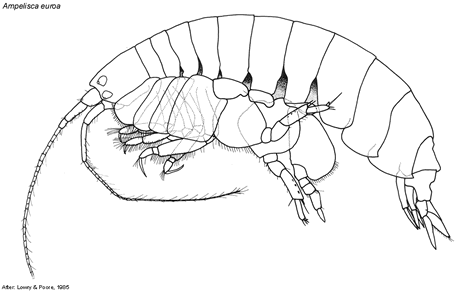 |
||||||
|
|
|
|
|
|
Australian Amphipoda: AmpeliscidaeJ.K. Lowry, P.B Berents & R.T. Springthorpe Ampelisca euroa Lowry & PooreAmplisca aequicornis. --Poore et al., 1975:33. Ampelisca euroa Lowry & Poore, 1985: 273, figs 13-14. Type material. HOLOTYPE: female, 9.0 mm, NMV J2133. PARATYPES: 11 specimens, AM P34171; 1 specimen, AM P34174; 3 specimens, AM P34175; 4 specimens, NMV J2134; 8 specimens, NMV J2135; 2 specimens, NMV J2136; 2 specimens, MV J2137. Type locality. Port Phillip Bay, Victoria (38º 02.3'S 144º 34.5'E), silty sand, 6 m depth. Description. Based on Lowry & Poore, 1985: 273, figs 13-14. Head longer than deep; rostrum present, acute; abutting antenna 1; lateral cephalic lobe absent; anteroventral margin oblique; eyes present, two pairs with cuticular lenses. Antenna 1 long, slightly shorter than to subequal in length to antenna 2; peduncular article 2 short (less than 1.5 x length of article 1). Mandible palp article 2 inflated. Peraeon. Coxae 1 to 3 without posteroventral hooks. Gnathopod 1 simple; propodus palm absent; coxa anterior margin slightly concave, anteroventral corner not produced. Peraeopods 5 and 6 carpus long, about 3 x as long as broad, slightly or not produced along posterior margin of propodus. Peraeopod 7 basis expanded posteriorly, posterior margin broadly rounded, ventral margin densely setose, free anterior margin lacking setae near junction with ischium; ischium longer than merus; merus anterior lobe absent, merus posterior lobe absent; carpus anterior lobe absent, short (about as long as broad); propodus subrectangular; dactylus broad at base, tapering distally. Pleon. Epimeron 3 posteroventral margin oblique, straight, corner with cusp, corner acute. Urosomite 1 without carina. Uropod 2 inner ramus with one dorsal row of robust setae; outer ramus without large subterminal robust setae. Uropod 3 rami, inner margins smooth proximally; outer ramus lanceolate. Telson longer than broad, deeply cleft, distal margin subacute, with mid-dorsal robust setae, inner margin without robust setae along inner margin, distal margin with apical setae. Habitat. Marine to Estuarine; sand to muddy sand bottoms. Depth zone. Littoral (0 to 30 m) to Continental shelf (30 to 200 m). Remarks. According to Lowry & Poore (1985) A. euroa is the most common ampeliscid species in south-eastern Australia. It occurs in estuaries and on the continental shelf from Port Stephens in New South Wales to Spencer Gulf in South Australia. In Port Phillip Bay A. euroa prefers sandy substrates where it has a mean density of 50 individuals per square metre (Poore et al., 1975). Distribution. New South Wales: Brooklyn, Hawkesbury River; Box Head, Broken Bay; east of Turrametta Heads, Dee Why and Long Reef; east of Bondi; east of Malabar; off Moona Moona Creek, Jervis Bay (Lowry & Poore, 1985); Twofold Bay (Hutchings, et al., 1989). Victoria: Port Phillip Bay; Crib Point; Western Port; off Cape Paterson; throughout Bass Strait (Lowry & Poore, 1985). South Australia: off Lowly Point, Spencer Gulf; American River Inlet, Kangaroo Island (Lowry & Poore, 1985). Geographic areas. South-eastern Australia to Southern Australia.
Cite this publication as: 'J.K. Lowry, P.B Berents & R.T. Springthorpe (2000 onwards). Australian Amphipoda: Ampeliscidae. Version: 21st September 2000. https://crustacea.net'. |
|
|
|
|
|
|
|
|
|
Copyright © Australian Museum, 2021
Australian Museum website
